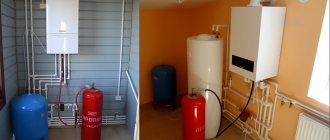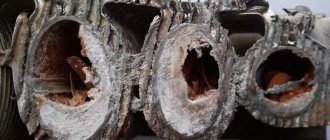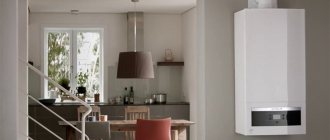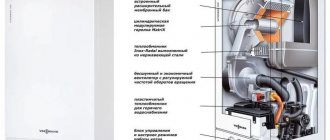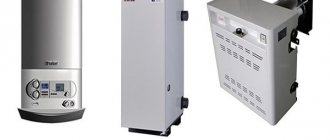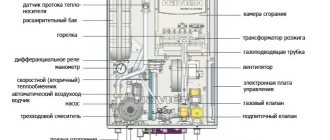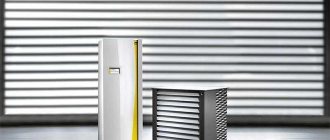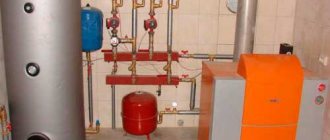If it is not possible to connect to the central gas pipeline, then some owners of private houses decide to install autonomous gasification. The heart of such a system becomes a gas boiler running on liquefied gas - the unit is connected to a gas holder or propane cylinders.
The boiler installation is capable of heating a room of any size. In order for the boiler to provide residents with the appropriate level of comfort, it is necessary to carefully consider the issue of its choice.
We will tell you how a gas unit works, what types of boilers are on the market, and what are the features of their installation and operation. So that you can decide on a purchase, we have listed the main selection criteria and prepared an overview of popular manufacturers of heating equipment.
General description and operating principle
Liquefied gas is a natural resource, artificially cooled to a temperature of -160 °C for ease of storage and transportation.
A boiler using this type of fuel is a traditional heat generator in appearance, design and type. It burns gaseous fuel and directs the resulting heat to heat the heat exchanger.
Boilers operating on liquefied gas can be switched to traditional main gas in the future if such communications appear near a residential premises. To do this, you will need to replace several working elements and reconnect the equipment to the centralized gas system
From there, the useful resource is “taken” by the coolant and transports it along the loop communications, thus heating houses and heating domestic water, if this is provided for by the design of the equipment.
Specific features of operation
The first main difference between the unit and analogues operating on traditional main gas is the ability to function efficiently even with reduced fuel pressure. The second is a special nozzle in which the nozzle holes have a reduced diameter, suitable specifically for a propane-butane mixture.
In order for the boiler to cope with heating a residential building and heating water for plumbing and domestic needs, it will need to be provided with the required volume of fuel. To do this, you will have to build a gas tank on the site (a reservoir located underground) or connect the equipment to propane cylinders
Some ]traditional gas boilers[/anchor] equip their products with injection systems so that, if necessary, customers can convert the equipment to liquefied fuel.
True, you will additionally have to install a special nozzle, reconfigure the gas valve and replace some parameters in the electronic board of the heat generator. But after all these steps, the boiler will work in a new mode, and customers will be able to effectively heat their homes with liquefied gas.
Installing a gas tank is one of the most effective ways to provide the boiler with working fuel. The storage volume can be chosen so that it will have to be refilled once a year or even less often, spending from 20 to 60 minutes on this
The uninterrupted operation of the device is guaranteed by the presence of constantly supplied fuel. These can be ordinary gas cylinders, combined into groups of 2 to 15 pieces, or different types of gas holders.
The supply lines are connected to the boiler via a gas reducer. It controls the supply of fuel and ensures its reasonable consumption - within 1.8-2.0 m3/h.
To quickly and inexpensively equip a fuel tank, you can purchase a mobile gas tank. It will instantly solve the problem with resource storage and will allow you to provide heating for a dacha or a not too large country house
The main functionality also includes a safety unit, consisting of safety valves, a temperature controller, flame and pressure sensors. A system equipped with these elements is easy to operate and does not create any problems for the owners during use.
Safety precautions when using gas cylinders
If liquefied gas is used to heat your home, you must adhere to the following safety requirements:
- When the system freezes, it is prohibited to use open flames to heat the cylinders. In case of any fire within the house, fuel containers must be removed as far as possible from the fire.
- If a separate room cannot be allocated for fuel containers, then it is impossible to install the cylinders near the cellar or basement, because the gas can fall down. If it gets into the basement, it can lead to an explosive situation or poisoning of people who go down into the room.
- When connecting containers, a leak meter must be installed to minimize the likelihood of explosion and fire.
- It is prohibited to store empty cylinders in the house. For these purposes, a separate building must be allocated, located no closer than 10 meters from the house.
Attention! To ensure safety, the system is inspected and preventive maintenance performed every 4 years.
Types of propane boilers
There are three types of units on the household equipment market. These are single-circuit, double-circuit and condensing boilers. They perform similar tasks, but differ in design and functionality.
Features of single-circuit devices
A boiler with one circuit is intended only for heating a room and is usually installed where water heating is solved in some alternative way.
The cost of single-circuit boilers is slightly lower than that of similar devices with two circuits. This is due to the fact that the equipment performs only a narrowly focused function - heating the home
The module is equipped with a closed combustion chamber, and during operation the boiler flame is enriched with oxygen coming from the room where the equipment is located. The materials waste during the combustion process are discharged to the street through a vertical chimney specially equipped for this purpose.
Nuances of double-circuit products
Devices equipped with two circuits effectively heat residential premises of any size and provide households with hot water. The coolant is heated by two burners, ignited using an igniter equipped with a built-in system of piezoelectric elements.
When the flame lights up, the temperature sensor is activated. Upon reaching certain indicators, it gives a signal to the automation, and access to the combustion chamber is closed.
If the unit has a closed combustion chamber, for correct operation and timely removal of combustion products it is necessary to install a coaxial chimney with a forced draft. This design will ensure a uniform flow of oxygen to the wick and ensure stable combustion
Waste materials and acidic impurities leave the room through a chimney or through a ventilation outlet.
How condensing units work
A condensing-type boiler supplies both heating and hot water for domestic purposes to a living space, but does it somewhat differently than a double-circuit boiler. In a condensing device, cold water, once in a heat exchanger, is heated by a burner and hot air.
A condensing boiler is a high-tech type of equipment and is very economical in fuel consumption. The exhaust gas temperature at the burner is 40°C, and the efficiency level reaches 97%. At the same time, heat loss does not exceed 0.5%
Then half of the liquid goes into the heating system communications, and the second half goes to the taps for washing, washing and other household needs. After going through a full cycle, the water from the radiator returns to the heat exchanger and the whole procedure is repeated again.
Is it economically profitable?
Statistics show that heating a 100 m2 building requires an average of 15 liters per day. But this parameter can vary significantly. It all depends on how insulated the house is, as well as on the air temperature outside.
Cylinders are available in different volumes: 50 l, 27 l, 10 l, 5 l. For heating a house, it is more advisable to take the largest volume - 50 liters. It holds 35-40 liters of gas. Now let's look at a simple example. To heat a house with an area of 70 m2 you will need about 2-3 cylinders for 1 week. This is provided that the temperature outside the window is -5°C. If it drops to -20°C, then heating the same house will take 5-6 cylinders for 7 days. As the square meters of housing increase, gas consumption increases proportionally.
If we add to this value the cost of gas refueling and delivery services, then heating turns out to be economically unprofitable. In addition, if the house is poorly insulated, then heat loss will increase. Accordingly, more gas will be required for home heating.
Types of products by location
Equipment operating on liquefied fuel can be floor-mounted or mounted. Each option has specific characteristics that make it attractive and practical under certain conditions.
Having this information in hand, owners can independently determine which device is most suitable for them, and then purchase it in a specialized store.
Option #1: floor equipment
Floor-standing devices are the most widespread. These are high-power units that can provide comfortable heat and hot water not only to standard residential buildings, but also to large-sized country cottages.
The main operating element of the devices is a pressurized gas burner. It has a good degree of efficiency and has high heat dissipation.
Floor-standing devices exhibit stable operation even with a strong drop in gas pressure in the system and reliably serve in intensive use for 15 to 25 years, depending on the manufacturer
The boilers are equipped with a cast iron or steel heat exchanger. The cast iron element is heavy and has a long service life. A steel object is much lighter, but exhibits fragility, sensitivity to mechanical damage and shock, and lasts for a shorter period of time.
In addition to basic elements, progressive modules contain all kinds of auxiliary equipment that increase operational safety. These are sensors for monitoring the draft level, coolant volume and presence of flame, as well as thermostats that block operation in the event of an abnormally high level of heating of the working fluid
Depending on the manufacturer, the device is equipped with a piezo or electronic ignition system. In the first option, the device is started manually by pressing a button.
In the second case, activation occurs automatically, and the boiler does not consume excess fuel during operation, since the system does not have a pilot light with a flame burning continuously.
Detailed information on the selection and installation of floor-standing gas boilers is presented in the articles:
- Floor-standing gas heating boilers: types, how to choose, review of the best brands
- Do-it-yourself installation of a floor-standing gas boiler according to technical installation standards
Option #2: wall mounted devices
Boilers designed for wall mounting are compact in size and have a modern appearance. They take up a minimum amount of space and are suitable for placement in small rooms with complex layouts.
The installation of a mounted boiler is always carried out by a specialist who has experience in such work. The equipment must be installed in accordance with the safety requirements for domestic gas systems
Functionally, wall-hung gas units are no different from floor-mounted ones, however, they have slightly less power and are not very suitable for use in large, spacious houses. But they use fuel economically, while providing a high level of comfort in the living space.
Refueling
Cylinders undergo mandatory certification once every 3 years - this is necessary for the user’s own safety. Such containers can serve for about 10 years. A standard home consumes about 10-12 cylinders per month, so they will have to be refilled weekly - you cannot transport more than 3 cylinders at a time without special permission.
Before filling, the vessels need to be prepared. To do this, you need to remove condensation, which artificially reduces the useful volume and harms the steel walls. Removing condensate is the prerogative of specialists; doing such work yourself is always a risk. If for some reason it is difficult to find a specialist, you will have to carry out the procedure yourself. The cylinder is taken out to an open space without sources of fire, grounded and then the reducer is removed. Leave for 2 hours to allow any remaining gas to evaporate. After two hours of inactivity, the vessel turns over and the water flows into the ground. You can take it to a gas station.
It is worth choosing a gas station that organizes both transportation and a guarantee for the work. It is better not to contact car stations, because their equipment does not have a special cut-off valve that regulates the filling of household gas cylinders. They also do not have a special connector for connecting the cylinder to station equipment.
Advantages and disadvantages of units
Boilers running on liquefied gas are cheaper than appliances using other types of resource.
Among the advantages of the equipment are such parameters as:
- Complete independence from centralized fuel supplies and regular price increases for utility services. The autonomy of the system ensures the absence of emergency situations.
- High level of efficiency - on average 92-95% and up to 97% for individual models.
- Quiet burner - for comparison, the burner device of a diesel boiler produces a noise effect of 60-75 dB.
- Easy to maintain . The equipment does not require labor-intensive and expensive maintenance, replacement of the fuel filter and nozzle, reconfiguration of the burner and cleaning of the heat exchanger.
- Possibility of working through main gas - in the future you can not buy a new boiler, but transfer the existing one to a centralized supply of blue fuel.
- Duration of operation - the service life of floor-mounted ones is up to 25 years, wall-mounted ones - 15-20 years, subject to qualified installation, compliance with operating rules and timely service.
- Safety of liquefied gas devices - the fuel does not ignite even when the container it contains is heated. Combustion occurs only at the moment of mixing the substance and oxygen, and this happens directly in the burner and only in it.
There are completely energy-independent products on sale that allow you to organize a full-fledged heating system in hard-to-reach conditions, for example, in remote forest areas or high in the mountains.
Of the disadvantages of devices, the following positions are the most significant:
- the need for constant high-quality work to connect the boiler to 3-4 propane cylinders using a reducer and ramp;
- It is not advisable to place containers with liquefied gas near the boiler - it is better to place them in nearby rooms equipped with a good ventilation system, or take them outside and install them in a special box;
- care and caution required when connecting the cylinder, since all operations are performed manually and require the use of physical force;
- subsequent conversion of some boiler models to use regular gas is expensive (replacing the burner costs 30-40% of the total price of the boiler);
- installation of the unit and connection to gas supply communications must be done by a licensed specialist with experience.
The balance of pros and cons must be considered in each individual case and, based on the conclusions drawn, a decision must be made regarding the advisability of purchasing this or that type of equipment.
The nuances of using cylinders in winter
If bottled gas is used to heat a country house, then in winter you need to take care to protect the fuel from freezing.
This is especially true for buildings for seasonal use, for example, dachas, when the owners come to the house only on weekends. If fuel containers are stored outside the house, then at sub-zero temperatures the pressure in them decreases. If the pressure drops significantly, heating equipment may stop working. To avoid this situation, containers with fuel during cold weather are installed in a special cabinet with a built-in ventilation system. Non-flammable insulation is used to insulate the cabinet.
If there is no such cabinet, then it is better to store containers with fuel in an extension to the house, in which there is no heating, but a positive temperature is constantly maintained due to good insulation. Do not forget about other safety requirements when choosing a suitable place to install cylinders for the winter.
Important selection criteria
When planning to purchase a device, you need to take into account such a parameter as the base power. This indicator is measured in kW and indicated in the documentation supplied with the boiler. The heated area is usually 9-10 times this value. For example, by purchasing a unit with a capacity of 10.5-11.3 kW, it will be possible to fully heat a house measuring about 100 sq.m.
When calculating the power/area ratio of a house, experts recommend making allowances for possible severe frosts during the winter season and purchasing a boiler with some reserve (about 15-20%). Otherwise, during periods of intense cold, the system will physically not be able to maintain a comfortable temperature in the room.
The efficiency of the unit is also very important. The higher this indicator, the more economically the boiler uses fuel resources, while ensuring the most efficient return. In models of the budget line, the coefficient usually fluctuates in the range of 90-94%.
For more advanced premium products it reaches 96-97%, but the cost of such units is an order of magnitude higher than the average price.
Another key item that cannot be ignored is fuel consumption. The data provided by the manufacturer in the accompanying documents is considered conditional.
How much gas gas boilers running on propane actually consume depends on the efficiency and power of the units, the set temperature in the living room, the actual heat loss of the building and other factors.
Only specialized specialists will be able to determine more accurate figures, but even their information will have an error of 10-15%.
Equipment using liquefied fuel must operate at a low pressure level in the system (no more than 3-5 mBar). Only such values make it possible to effectively produce gas from cylinders in full and without residue
If your plans include organizing only a heating system, a single-circuit boiler is suitable for purchase. When you also need to provide hot water, you will have to purchase a condensing or dual-circuit gas unit with an open or closed combustion chamber.
For a large residential cottage, it is better to choose a floor-standing device. It has more power and can provide the room with useful heat and the required volume of hot water.
For a medium or small house, or an apartment on the ground, a compact hanging device will be sufficient. When placed, it will not take up much space and will harmoniously fit into any type of interior design.
Is it possible to somehow save liquefied gas consumption?
Such a sensor is installed in a boiler room Source tion.ru
Yes, it is indeed possible if you follow all the recommendations and rules. There are not many of them, but they still exist and help save the family budget for those who adhere to them:
- Insulate the house. External insulation turns out to be more effective than internal insulation.
- Replace old windows and doors with new ones so that the shutter strips fit tightly in all places, preventing cold air from entering from the street.
- The difference in air temperature in the boiler room and the heated room should not exceed 2-3°C. To do this, in the room where the boiler is installed, you can even put a homemade register welded from a metal profile.
- Refill cylinders and tanks only at proven gas stations so that there are no foreign impurities in the LPG.
- Use automation to regulate the temperature in the heating circuit. Its indicators must correspond to the desired air temperature in the room.
- Install a monitoring sensor that detects carbon dioxide leaks. If there is one, then you will have to constantly ventilate the boiler room, which means additional costs for heating the room.
Rating of popular models and manufacturers
Siberia boiler , manufactured at the domestic enterprise JSC Rostovgazoapparat, is the best-selling module among all those presented on the gas equipment market today.
It is a non-volatile unit with a highly reliable Eurosit automation system, made in Italy and fully adapted to domestic operating conditions.
The Siberia device consists of durable, high quality materials. The layer of thermal insulation coating available on all models makes operation safe and protects the user from burns and other potential injuries.
The heat exchange tank is boiled automatically and due to this it has increased strength. Double-circuit boilers are equipped with a flow-through copper circuit for efficient heating and subsequent supply of hot water to the system.
The module is controlled at an intuitive level and does not create difficulties even for those users who are not familiar with technology.
The models are presented in the widest range and various sizes, they are safe and silent. The high quality of the products is confirmed by standard certification certificates, and the reasonable cost of the devices makes them doubly attractive in the eyes of buyers.
High-quality equipment that is competitive in all respects is supplied to the Russian market by the Italian company Ferroli . The products of this company are distinguished by a stylish, modern design and a convenient control panel that displays the general operating mode of the equipment and temperature indicators.
The Ferroli boiler is equipped with a progressive and convenient system that protects equipment from freezing. The design provides the ability to connect a room thermostat and a remote control function at the user’s request.
Among the main features of the equipment is a compact copper heat exchanger, created using technology patented by the company. It consists of 3 communication tubes connected in series into a single complex.
Inside them there are serpentine DHW elements, and the outer part has an anti-corrosion coating made on the basis of an aluminum alloy. The boiler is the smallest and lightest unit on the market.
The German corporation Bosch offers convection turbocharged boilers designed for wall mounting. They operate correctly at low gas pressure in the system and provide the room with adequate heat in the required volume.
The control unit of the unit contains a temperature limiter that prevents overheating of the heat exchanger and a pressure sensor that protects the equipment from operation when there is no coolant in the system
No less high-quality and practical boilers for operating on liquefied gas are supplied by the Viessmann (Germany). The product line includes both floor-mounted high-power modules and wall-mounted compact units for small rooms.
German devices operate silently, demonstrate a high level of efficiency and reliably serve for many years
All processes are fully automated, and some premium models have the ability to connect SMS notifications or open access to control via the Internet.
In addition to classic ones, the company also produces condensation products. They consume fuel with extreme efficiency and provide heat transfer of 97%. The heat exchange device in them is made of steel, and the presence of a controller allows the user to install an additional thermostat.
Advantages
Each heating method for a private home has its own advantages and disadvantages. Knowing about them, you can decide whether one or another method is suitable for a particular home. Advantages of gas cylinder heating:
- Inexpensive fuel price. Today the cost of gas is not the most expensive in the energy market.
- Availability. Not every locality has a gas pipeline. Gas cylinders can be bought at any construction hypermarkets and pumped at special stations.
- Autonomy. Can be installed separately and does not depend on external factors. Connection does not require a gas line. The cylinder can be brought anywhere.
- Stability . Fuel is supplied under a certain pressure. It does not jump in the pipes and does not change, it flows evenly.
- Durability. The cylinders last a long time and can be refilled many times. If necessary, all equipment can be resold on the secondary market without any problems.
- Heating water. Another plus is the ability to provide the house with hot water.
Heating a house 100 m²
Really, honestly, really
| Heating a house 100 m² from | RUR 49,500 |
| Installation of heating boiler | 8,000 rub. |
| Installation of heating radiators (no more than 10 pieces)!!! The cost of installing a standard (mounted, not in-floor convector) heating radiator is 4,000 rubles | 25,000 rub. |
| Radiator pipe routing | 12,000 rub. |
| Pressure testing and filling with coolant | 4,500 rub. |
| TOTAL turnkey: | RUB 49,500 |
| Drilling holes, rigging, dismantling, paid extra | according to_estimate |
Heating a house 100 m² Attention. This cost is a preliminary estimate; these prices should only be used as approximate prices. The exact cost of the work is calculated after an engineer visits the work site, its complexity, and quantity.
